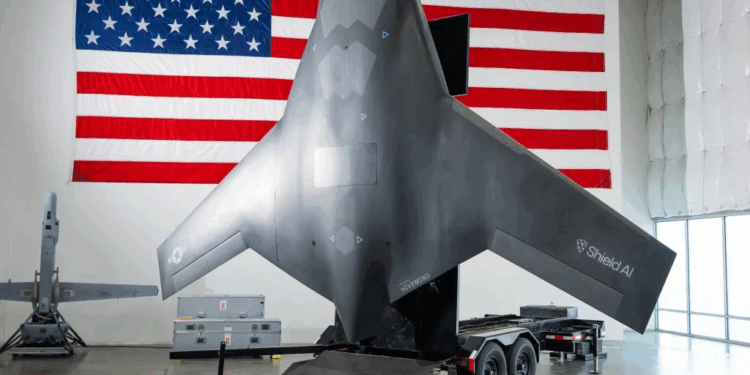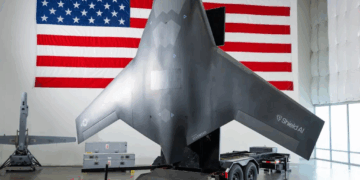Shield AI has introduced X-BAT, a runway-independent, jet-powered VTOL unmanned combat aircraft that lands tail-first after missions. Built around the company’s Hivemind autonomy and lessons from the V-BAT family, X-BAT targets the CCA/UCAV market with a design focused on survivability, mission flexibility, and cost disruption.

Why X-BAT matters
- Runway independence = ground survivability. War-games consistently show more aircraft lost on the ground than in the air. By taking off and landing vertically, X-BAT can disperse, hide, and operate from austere sites ashore or at sea, blunting runway-cratering campaigns and reducing tanker dependence in wide theaters like the Pacific.
- Multi-role by design. Air-to-air, air-to-surface, air-to-ground, EW, and ISR in one airframe reduces the need for bespoke fleets as threat environments shift.
- Autonomy-first architecture. Unlike ‘loyal wingmen’ tethered to a manned quarterback, X-BAT is sized and powered to carry its own sensors, C2, and EW, enabling standalone operations with the option to collaborate.
At-a-glance specs (company figures)
| Attribute | X-BAT |
|---|---|
| Configuration | Jet-powered, VTOL, “cranked-kite” planform |
| Length | ~26 ft |
| Wingspan | ~39 ft |
| Height | ~4.7 ft |
| Propulsion | Single afterburning jet engine |
| Max range | ~2,000 nm |
| Service ceiling | ~50,000 ft |
| Modularity | Open mission system architecture, swappable payloads |
| Launch/Recovery | Trailer or shipboard pad; vertical, runway-independent |
Design philosophy & pedigree
Shield AI’s aircraft division, led by Armor Harris (ex-SpaceX Starshield and Starlink engineering leader with vertical-landing program experience), frames X-BAT as a “weapon system” rather than just an airframe: VTOL basing, multi-mission payload bays, and autonomy stack integrated from day one. The goal is fifth-gen-like effects at a fraction of lifecycle cost.
Operational advantages
- Dispersed basing & maritime flexibility
Operates from island pads, roads, small decks, and mobile trailers, enabling deception, rapid repositioning, and sortie generation without fixed runways. - Tanker relief
Closer forward basing and 2,000-nm class reach reduce tanker exposure in anti-access environments. - Mission agility
Open architecture eases integration of new sensors, effectors, and behaviors (A2A intercept, DEAD/SEAD support with launched effects, stand-in EW, maritime ISR/strike). - Human-on-the-loop autonomy
Hivemind supports collaborative behaviors when needed but preserves true standalone options for contested C2.
The X-BAT concept faces several potential roadblocks. First, combining VTOL with a jet airframe is inherently complex: high-energy vertical recoveries, thermal and structural loads, and shipboard integration are all non-trivial engineering challenges. Second, there are payload-range trade-offs to reconcile, as VTOL penalties must be balanced against endurance and weapons carriage. Third, certification and trust in autonomy will be critical; getting a “fighter-class” unmanned system cleared for high-end missions requires rigorous safety processes, rules-of-engagement compliance, and thorough verification. Finally, competing in the higher-end air-combat tier demands true industrial scale—robust manufacturing, resilient supply chains, and sustained funding.

Despite these hurdles, X-BAT could fit in multiple roles. As a CCA adjunct, it can operate as an autonomous striker or sensor within manned-unmanned teams, or act independently as a hunter-killer against time-sensitive targets. It also enables maritime distributed operations from small combatants or expeditionary sea bases, delivering long-range ISR, electronic warfare, and anti-surface strike without carrier decks. In austere expeditionary airpower scenarios, it can rapidly seed combat power into contested islands or forward FARPs without the need to build runways.









